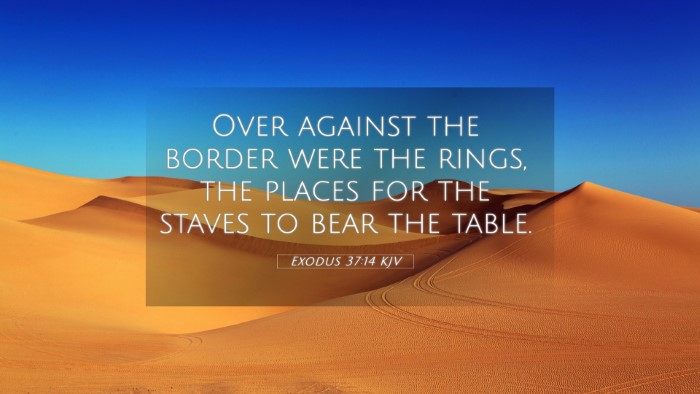Exploration of Exodus 37:14
Verse: Exodus 37:14
Exodus 37:14 reads, "And he put the staves into the rings by the sides of the ark, to bear the ark." This verse describes a significant aspect of the construction of the Ark of the Covenant as directed by God to Moses. The verse emphasizes the care and specific instructions given for transporting the holy ark, highlighting its sacredness and the reverence with which it must be handled.
Interpretation and Significance
The act of placing staves into the rings represents the importance of mobility in the physical presence of God's covenant. The Ark was designed not only as a stationary object but as something that could be carried, emphasizing the relationship between God and His people, who required a means to access His presence on their journey through the wilderness.
Insights from Biblical Commentaries
Matthew Henry: Henry notes that the use of staves was to ensure that the Ark could be borne without touching it directly. This act signifies the holiness of God and points to the respectful distance the Israelites needed to maintain in handling sacred items.
Albert Barnes: Barnes elaborates on how this practice reflects the principle of holiness in worship and the necessity of following divine instructions with precision. The staves signify readiness for God's move and serve as a practical way to uphold the sanctity of the Ark.
Adam Clarke: Clarke emphasizes the symbolism behind the Ark being carried by staves, arguing that it represents the support of God upon His people. He also points out the necessity of obedience to God’s commands to maintain a relationship of covenantal fidelity.
Thematic Bible Verse Connections
- 1 Samuel 6:7: Discusses the Ark being transported, and how the Philistines treated it.
- Numbers 4:15: Instructions for the sons of Kohath regarding how to carry the Ark.
- Deuteronomy 10:8: Mentions the Ark being a symbol of God's presence among His people.
- Psalms 132:8: Invokes the need for God to arise and dwell in His sanctuary.
- Hebrews 9:4: References the contents of the Ark including the pot of manna and Aaron’s rod.
- 2 Samuel 6:6-7: Relates to the story of Uzzah and the mishandling of the Ark.
- Revelation 11:19: Alludes to the Ark in a heavenly vision, connecting the Old and New Testament themes.
Cross-Reference Insights
Cross-referencing Exodus 37:14 with other biblical texts reveals a coherent narrative about God’s presence and the importance of service to Him. The following are significant connections:
- Exodus 25:10: Initial instructions for constructing the Ark.
- Deuteronomy 31:9: Moses writes the law and gives it to the priests who are to carry the Ark.
- Joshua 3:6: The Ark goes ahead of the people, leading them into the Promised Land.
- Micah 6:5: Highlights God's guidance leading Israel out of Egypt with “the staff of Moses.”
- Matthew 28:20: Connects the promise of God’s presence with believers, affirming a continuity between the Old and New Testaments.
- Acts 7:45: Mentions how the Ark brought by the Israelites from the wilderness to the land of promise.
- 1 Chronicles 13:7: Discusses the transportation of the Ark to David’s city, showcasing the continuous importance of the Ark in Israel's history.
Conclusion: The Role of the Ark in Spiritual Understanding
The significance of Exodus 37:14 extends beyond a mere instruction on carrying an object; it encapsulates the essence of God’s covenant with humanity. The Ark, with its designed staves, enables an inter-Biblical dialogue about the significance of God's presence that is a constant theme from the Old Testament through the New Testament.
The act of carrying the Ark encapsulates a much larger theological theme: how God interacts with His creation. By understanding Exodus 37:14 in the context of related scripture, one can grasp a more profound understanding of God's holiness, the requirements for His people, and the continuity of His presence throughout Biblical history.


